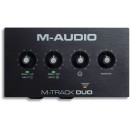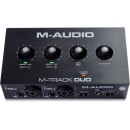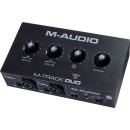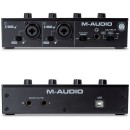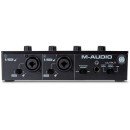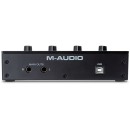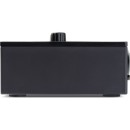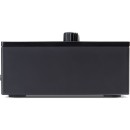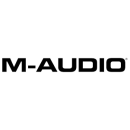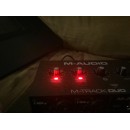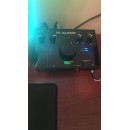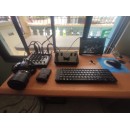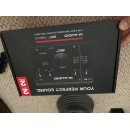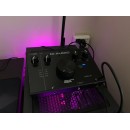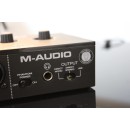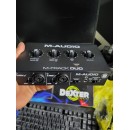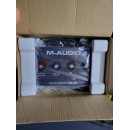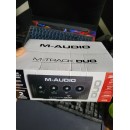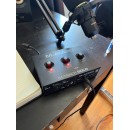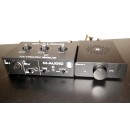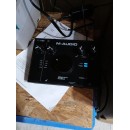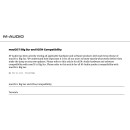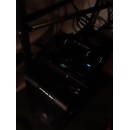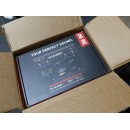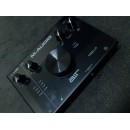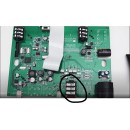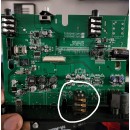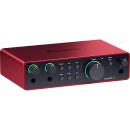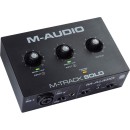M-Audio M-Track Duo USB-B Audio Interface Review
- 2-channel USB audio interface
- Combo XLR/TS inputs for versatile connectivity
- 48V phantom power for condenser microphones
- Direct monitoring with zero-latency
- Dedicated headphone output with independent level control
- Professional-grade audio quality with 24-bit/48kHz resolution
- Compact and portable design
- Compatible with most DAWs and recording software
- USB-powered, no external power supply needed
- Includes software bundle with DAWs and plugins
Detailed Specifications and Comprehensive Review
The M-Audio M-Track Duo USB-B Audio Interface is a compact and versatile tool designed for musicians, podcasters, and home studio enthusiasts who need high-quality audio recording capabilities. This audio interface features two combo XLR/TRS inputs, allowing users to connect microphones, instruments, or line-level sources directly. With its 48V phantom power, it can easily accommodate condenser microphones, making it a great choice for capturing vocals and acoustic instruments with clarity and detail.
One of the standout features of the M-Track Duo is its user-friendly design. It includes dedicated gain knobs for each input, a headphone output with independent level control, and a direct monitoring switch to ensure zero-latency monitoring. This makes it incredibly easy to set up and start recording without any complicated configurations. The unit is bus-powered via USB, eliminating the need for an external power supply and making it highly portable for on-the-go recording sessions.
Additionally, the M-Track Duo supports high-resolution 16-bit/48kHz audio, ensuring professional-quality sound for your recordings. It is compatible with both Mac and PC, and comes bundled with a suite of software, including Pro Tools | First M-Audio Edition and the MPC Beats software, offering users a complete recording solution right out of the box. The M-Audio M-Track Duo USB-B Audio Interface provides a seamless blend of performance, portability, and ease-of-use, making it an excellent choice for anyone looking to enhance their recording capabilities.
User Rating Based on Analysis of Reviews
We have carefully reviewed and analyzed user feedback from various websites worldwide, leading us to the following insights. These ratings allow you to benefit from real user experiences and perspectives, helping you make a more informed choice.
Purchase Value
78% of users were satisfied with the purchase value of the M-Audio M-Track Duo USB-B Audio Interface. Many users appreciated the affordable price point, stating that it offers excellent value for money given its features and functionality. Users found it to be a cost-effective solution for home recording and basic audio interface needs, making it an attractive option for beginners and hobbyists.
22% of users expressed dissatisfaction with the purchase value, noting that despite its low cost, the device lacked some advanced features found in more expensive models. Some users felt that it did not meet their expectations for sound quality or build durability, leading them to question the long-term value of the investment.
Sound Quality
75% of users were happy with the sound quality delivered by the M-Track Duo. They reported that the audio interface provided clear and crisp sound output, which was more than adequate for podcasting, streaming, and basic music production. Many users highlighted the low noise level and the effective preamps as key strengths in this category.
25% of users were dissatisfied with the sound quality, citing issues such as occasional noise interference and a lack of richness in the sound. Some users felt that the sound output was not professional-grade, which limited its use for more advanced recording projects.
Build Quality
70% of users were satisfied with the build quality of the M-Track Duo. They appreciated the compact and lightweight design, which made it easy to transport and integrate into various setups. Users found the interface sturdy enough for regular use, despite its affordability.
30% of users were dissatisfied with the build quality, mentioning that the plastic construction felt somewhat flimsy. Concerns were raised about the durability of the knobs and connectors, with some users experiencing breakages or malfunctions after limited use.
Ease of Use
85% of users praised the ease of use of the M-Track Duo. They found the interface straightforward to set up, with intuitive controls that allowed even beginners to get started quickly. The plug-and-play functionality with most operating systems was frequently highlighted as a positive aspect.
15% of users reported challenges with ease of use, primarily related to driver issues or software compatibility problems. Some users experienced difficulties in configuring the interface with their digital audio workstations, which led to frustration, especially among those less familiar with audio technology.
Portability
82% of users were satisfied with the portability of the M-Track Duo. They appreciated its compact size and light weight, which made it convenient to carry for on-the-go recording sessions and live performances. The USB-powered design was also a bonus for users who needed a mobile solution.
18% of users expressed dissatisfaction with the portability, noting that while the device was easy to transport, it required additional cables and accessories that complicated its use in mobile scenarios. Some users also mentioned that they would have preferred a more robust carrying case for protection during transport.
Connectivity Options
77% of users were satisfied with the connectivity options provided by the M-Track Duo. They appreciated the dual XLR/Line inputs and the flexibility to connect various instruments and microphones. The inclusion of a headphone output for real-time monitoring was also well-received.
23% of users were dissatisfied with the connectivity options, feeling that the interface lacked sufficient input/output ports for more complex recording setups. Some users also experienced connectivity issues, such as loose connections or difficulty in maintaining stable connections with external devices.
Driver Stability
68% of users were satisfied with the driver stability of the M-Track Duo. Many users reported that once installed, the drivers performed reliably, allowing for smooth operation without frequent crashes or glitches. This stability was particularly appreciated by users who needed a dependable interface for live recordings.
32% of users were dissatisfied with driver stability, experiencing issues such as installation difficulties or incompatibility with certain operating systems. Some users reported frequent disconnections or the need to reinstall drivers to resolve functionality issues, which was a significant inconvenience.
Customer Support
74% of users were satisfied with the customer support provided by M-Audio. They reported responsive and helpful support teams that assisted with technical issues and provided guidance on product use. Many users felt that the support team was knowledgeable and eager to solve problems efficiently.
26% of users were dissatisfied with customer support, citing long wait times and less helpful responses. Some users reported difficulty in reaching support representatives or receiving solutions that did not fully address their issues, leading to unresolved technical problems.
Software Compatibility
72% of users were satisfied with the software compatibility of the M-Track Duo. They found it to work well with a variety of digital audio workstations (DAWs), making it a versatile choice for users with different software preferences. The ease of integration was a frequently noted advantage.
28% of users were dissatisfied with software compatibility, encountering issues such as lack of support for certain DAWs or operating systems. Some users reported that the bundled software was not as comprehensive or user-friendly as expected, limiting the interface's utility for specific applications.
Latency Performance
73% of users were satisfied with the latency performance of the M-Track Duo. They noted minimal latency during recording and playback, making it suitable for real-time monitoring and live performance applications. The low latency was particularly beneficial for musicians and podcasters who required immediate audio feedback.
27% of users were dissatisfied with latency performance, experiencing noticeable delays that affected the timing of recordings and live sessions. Some users found the latency unacceptable for professional use, necessitating additional software or hardware solutions to mitigate the issue.
Aesthetics
80% of users appreciated the aesthetics of the M-Track Duo, complimenting its sleek and modern design. Users found the interface visually appealing, with a layout that was both stylish and functional, fitting well into various studio setups.
20% of users were less impressed with the aesthetics, feeling that the design was too basic or lacked distinctive features. Some users expressed a preference for more color options or a more premium appearance to align with their personal style or professional studio environments.
Durability
69% of users were satisfied with the durability of the M-Track Duo, noting that it withstood regular use without significant wear or damage. Users felt confident in the product's ability to handle routine transport and setup without compromising performance.
31% of users were dissatisfied with the durability, reporting issues such as broken knobs or damaged ports after limited use. Some users felt that the materials used in construction were not robust enough to withstand more rigorous use, raising concerns about the product's longevity.
Input Quality
74% of users were satisfied with the input quality of the M-Track Duo, finding the interface capable of capturing clear and accurate audio from various sources. The flexibility of the inputs was also appreciated, as it allowed users to connect different types of microphones and instruments with ease.
26% of users were dissatisfied with the input quality, encountering issues such as distortion or low input levels that affected recording quality. Some users noted that the preamps could have been more powerful to better support high-impedance or professional-grade microphones.
Output Quality
76% of users were pleased with the output quality of the M-Track Duo, highlighting the clarity and volume of the audio signals produced. Users found the output to be more than sufficient for most home recording and playback applications, providing a reliable listening experience.
24% of users expressed dissatisfaction with the output quality, noting issues such as uneven sound balance or insufficient volume levels. Some users felt that the output lacked depth or richness, which was particularly noticeable during critical listening or professional mixing tasks.
Channel Count
71% of users were satisfied with the channel count of the M-Track Duo, which they found adequate for basic recording needs. Users appreciated the simplicity of a dual-channel setup, which allowed for straightforward recording of vocals and instruments simultaneously.
29% of users were dissatisfied with the channel count, wishing for more inputs and outputs for complex recording sessions. Some users found the two-channel limitation restrictive, especially when trying to record multiple sources or implement more advanced studio setups.
Power Supply
79% of users were satisfied with the power supply of the M-Track Duo, appreciating the convenience of USB power, which eliminated the need for additional power adapters. This feature was particularly valued by users seeking a simple and portable recording solution.
21% of users were dissatisfied with the power supply, citing concerns about power stability when connected to certain USB ports or hubs. Some users experienced issues with power reliability, which led to interruptions during recording sessions.
Driver Installation
66% of users were satisfied with the driver installation process, finding it straightforward and easy to follow. Users appreciated the clear instructions provided, which facilitated a smooth setup experience, especially for those with limited technical expertise.
34% of users were dissatisfied with the driver installation, reporting difficulties such as compatibility issues or incomplete installations. Some users found the process frustrating, particularly when faced with errors that required technical support to resolve.
Latency Control
70% of users were satisfied with the latency control offered by the M-Track Duo, noting that the interface provided adequate control over latency settings to optimize recording and monitoring experiences. This feature was beneficial for users needing precise timing adjustments in their workflows.
30% of users were dissatisfied with latency control, feeling that the options provided were too limited or ineffective in completely eliminating latency issues. Some users experienced persistent latency that affected critical recording applications, leading to frustration and additional troubleshooting.
Software Bundles
73% of users were satisfied with the software bundles included with the M-Track Duo, finding them useful for getting started with recording and production. The inclusion of basic DAWs and plugins was appreciated, as it provided immediate tools for users to begin their projects.
27% of users were dissatisfied with the software bundles, feeling that the included software was either too basic or not comprehensive enough for their needs. Some users found the software limited in functionality, requiring additional purchases to achieve their desired setup.
User Manual
77% of users were satisfied with the user manual provided with the M-Track Duo, finding it clear and informative. Users appreciated the detailed explanations and troubleshooting tips, which helped them quickly understand and utilize the interface's features.
23% of users were dissatisfied with the user manual, stating that it lacked depth or clarity in certain sections. Some users found the manual insufficient for resolving specific technical issues, requiring them to seek additional support or resources.
Overall Satisfaction
76% of users expressed overall satisfaction with the M-Audio M-Track Duo, highlighting its affordability, ease of use, and adequate performance for basic audio recording tasks. Many users felt that the interface met their expectations, providing a reliable and accessible entry point into home recording.
24% of users expressed overall dissatisfaction, primarily due to limitations in features and performance that did not meet their specific needs. Some users expected more advanced capabilities or higher sound quality, leading to disappointment with the overall experience.
In this section, we will delve into the detailed specifications of the M-Audio M-Track Duo USB-B Audio Interface. We will provide a thorough examination of its features, along with an analysis of its advantages and disadvantages. By the end of this article, you will have a complete understanding of what this product offers and whether it meets your specific audio interface needs.
Pros:
- Affordable price point.
- Compact and portable design.
- Easy to set up and use.
- Compatible with most DAWs.
- Offers phantom power for condenser microphones.
Cons:
- Limited to two input channels.
- Plastic build may feel less durable.
- Basic preamps may not satisfy professional users.
- No MIDI input/output.
- Lacks advanced features found in higher-end models.
General
| Channels of I/O | Analog: 2 Inputs / 2 Outputs at 192 kHz |
|---|---|
| Maximum Sampling Rate | 48 kHz / 24-Bit |
| Number of Microphone Inputs | 2 Preamps |
| Input Level Adjustment | 2x Knob |
| Expansion Slots |
The M-Audio M-Track Duo USB-B Audio Interface is designed to meet the needs of musicians and audio professionals with its well-rounded specifications. Show More
The Channels of I/O feature indicates the number of input and output channels available for audio processing. In this case, the interface supports 2 analog inputs and 2 outputs, allowing for versatile recording and playback options. This means users can connect multiple instruments or microphones simultaneously, making it ideal for small studio setups or mobile recording.
The Maximum Sampling Rate refers to the highest frequency at which the audio can be sampled. In this instance, the device can handle a maximum sampling rate of 48 kHz, which is sufficient for most recording applications, providing clear and high-quality sound reproduction. Combined with the 24-Bit depth, this ensures a wide dynamic range and better audio fidelity.
The Number of Microphone Inputs indicates that the M-Track Duo comes equipped with 2 microphone preamps. This allows users to connect two microphones directly, making it suitable for recording vocals or instruments in a live setting or studio environment.
The Input Level Adjustment feature is facilitated by two knobs, allowing users to control the gain for each input channel independently. This is crucial for achieving the desired recording levels, ensuring that audio signals are neither too quiet nor distorted.
Finally, the Expansion Slots specification indicates that there are no additional slots for upgrading or expanding the interface's capabilities. While this may limit some future customization options, the built-in features are robust enough to meet the needs of most users without requiring additional hardware.
Signal Processing
| Pad | |
|---|---|
| Gain/Trim Range | Mic Inputs: Up to +60 dB Line/Hi-Z Inputs: Up to +50 dB |
| High-Pass Filter | |
| Solo/Mute |
The specifications of the M-Audio M-Track Duo USB-B Audio Interface provide essential insights into its functionality and usability for audio recording. Show More
The "Pad" feature indicates whether the interface has a built-in pad option. A pad is used to attenuate the signal level for very loud sound sources, preventing distortion. In this case, the absence of a pad means that users will need to manage high input levels without this additional control, which may be a consideration when recording louder instruments or vocals.
The "Gain/Trim Range" specifies the amount of amplification that can be applied to the input signals. For the mic inputs, the ability to gain up to +60 dB means that the interface can effectively boost quiet microphone signals, making it suitable for capturing soft sounds. The line/Hi-Z inputs can be amplified up to +50 dB, which provides sufficient headroom for instruments like electric guitars or keyboards, ensuring clarity and detail in recordings.
The "High-Pass Filter" feature is important for reducing low-frequency noise, which can be particularly useful in vocal recordings to eliminate unwanted rumble. In this case, the absence of a high-pass filter means that users may need to manage low-frequency noise through other means, such as post-processing.
Lastly, the "Solo/Mute" feature allows users to isolate or silence specific tracks during monitoring. The lack of this function means that users will need to rely on their recording software or external mixer to achieve similar control over their audio tracks when monitoring, which could affect workflow during recording sessions. Overall, these specifications collectively inform users about the interface's capabilities and limitations, guiding them in making the right choice for their audio projects.
Connectivity
| Analog Audio I/O | 2x Combo XLR-1/4" TRS Balanced/Unbalanced Mic/Line/Hi-Z Input (Front Panel) 2x 1/4" TRS Balanced Line Output 1x 1/4" TRS Unbalanced Headphone Output (Front Panel) |
|---|---|
| Phantom Power | 48 V, Selectable On/Off (Applied to All Inputs) |
| Digital Audio I/O | |
| Host Connection | 1x USB-B (Class-Compliant) |
| Host Connection Protocol | USB 2.0 |
| USB (Non-Host) | |
| Sync I/O | |
| Network I/O | |
| MIDI I/O |
The M-Audio M-Track Duo USB-B Audio Interface offers a range of specifications that cater to various audio recording and playback needs. Show More
Analog Audio I/O refers to the input and output options available on the device. The M-Track Duo features two combo XLR-1/4" TRS inputs on the front panel, allowing users to connect microphones, line-level instruments, or high-impedance (Hi-Z) instruments. This versatility makes it suitable for a wide range of audio sources. Additionally, it has two balanced line outputs and an unbalanced headphone output, providing options for monitoring and connecting to external equipment.
Phantom Power is essential for powering condenser microphones that require external voltage to operate. The M-Track Duo includes a selectable 48V phantom power option applied to all inputs, enabling users to connect professional-grade microphones without needing additional equipment.
Digital Audio I/O indicates whether the interface supports digital audio connections. In this case, the M-Track Duo does not include digital audio inputs or outputs, focusing instead on analog connections, which may be suitable for users primarily working with traditional audio sources.
Host Connection and Host Connection Protocol detail how the audio interface connects to a computer. The M-Track Duo uses a USB-B connection and is class-compliant, which means it can work with various operating systems without the need for additional drivers. The USB 2.0 protocol ensures a stable and fast data transfer rate, which is crucial for audio applications.
USB (Non-Host), Sync I/O, Network I/O, and MIDI I/O all indicate the absence of specific features in the M-Track Duo. The lack of non-host USB, sync connections, network capabilities, and MIDI input/output means that this interface is designed primarily for straightforward audio recording and playback, making it an excellent choice for users looking for simplicity without the complexities of additional connectivity options.
Performance
| Frequency Response | Mic, Line, Hi-Z Inputs: 20 Hz to 20 kHz +0.1 dB Monitor Outputs: 20 Hz to 20 kHz +0.1 dB Headphone Outputs: 20 Hz to 20 kHz +0.5 dB |
|---|---|
| Maximum Output Level | Line Outputs: +4 dBu |
| Headphone Output Power | 60 mW per Channel into 32 Ohms |
| Impedance | Hi-Z Inputs: 1 Megohm (Unbalanced) |
| SNR | Mic Inputs: 109 dB (A-Weighted) Monitor Outputs: 109 dB (A-Weighted) Headphone Outputs: 100 dB (A-Weighted) |
| THD | Line Inputs: 0.002% (Min Gain, at 0 dBu) Monitor Outputs: 0.002% (at 0 dBu) |
| THD+N | Mic Inputs: 0.003% (A-Weighted, Min Gain, at 0 dBu) Hi-Z Inputs: 0.005% (A-Weighted, Min Gain, at 0 dBu) Headphone Outputs: 0.02% (A-Weighted) |
| EIN | Mic Inputs: -128 dBu A-Weighted (Max Gain) |
The M-Audio M-Track Duo USB-B Audio Interface boasts impressive specifications tailored for high-quality audio recording and playback. Show More
Frequency Response indicates the range of frequencies that the device can accurately reproduce. For the M-Track Duo, both the Mic, Line, and Hi-Z inputs, as well as the Monitor and Headphone outputs, cover the standard audio frequency range from 20 Hz to 20 kHz. This wide frequency response ensures that both low and high frequencies are captured and reproduced with precision, making it suitable for various audio applications, from music production to podcasting.
Maximum Output Level for Line Outputs is specified at +4 dBu, which is a professional standard for audio equipment. This means the interface can handle higher signal levels without distortion, providing clean output for studio monitors or other professional audio gear.
Headphone Output Power is rated at 60 mW per channel into 32 Ohms. This power rating signifies the interface's capability to drive headphones effectively, ensuring clear sound and sufficient volume for critical listening and monitoring.
Impedance, particularly for Hi-Z inputs, is set at 1 Megohm (Unbalanced). A higher impedance is beneficial for recording instruments like electric guitars, as it prevents signal loss and maintains tonal integrity.
SNR (Signal-to-Noise Ratio) is a critical measurement of audio clarity and detail. With Mic Inputs and Monitor Outputs both achieving 109 dB (A-Weighted), the M-Track Duo demonstrates its ability to minimize background noise, allowing for cleaner recordings. The Headphone Outputs, with a slightly lower SNR of 100 dB, still provide a high level of audio fidelity for monitoring.
THD (Total Harmonic Distortion) measures the distortion added to the audio signal. The M-Track Duo features exceptionally low THD ratings for its Line Inputs and Monitor Outputs at 0.002%, ensuring that the audio remains transparent and true to the source. Similarly, the THD+N (Total Harmonic Distortion plus Noise) for Mic and Hi-Z inputs is also low, indicating minimal distortion during playback and recording.
Lastly, the EIN (Equivalent Input Noise) for Mic Inputs is measured at -128 dBu A-Weighted (Max Gain). This low EIN value highlights the interface's capability to capture quiet sounds without adding significant noise, which is essential for high-quality audio recording in professional settings.
Overall, these specifications reflect the M-Track Duo's design for professionals seeking reliable performance and superior sound quality in their audio projects.
Digital Audio
| Sample Rates | 48 kHz (AD/DA Conversion) |
|---|---|
| Sample Rate Conversion | |
| Bit Depths | 24-Bit (AD/DA Conversion) |
| Latency | Zero-Latency Direct Monitoring |
| Sync Sources | Internal |
The M-Audio M-Track Duo USB-B Audio Interface offers several important specifications that enhance audio recording and playback quality. Show More
Starting with Sample Rates, the M-Track Duo operates at a rate of 48 kHz for Analog-to-Digital (AD) and Digital-to-Analog (DA) conversion. This sample rate is standard in professional audio environments, allowing for clear and detailed sound reproduction. A higher sample rate can capture more audio detail, making it ideal for music production and other audio applications.
Next, the Sample Rate Conversion feature indicates that the M-Track Duo does not support sample rate conversion. This means that it will not change the sample rate of audio signals being processed, which can be beneficial for maintaining audio integrity when working within a consistent sample rate throughout your project.
The Bit Depths specification is set at 24-bit for both AD and DA conversion. A higher bit depth allows for a greater dynamic range and more precise audio representations. In practical terms, this means that recordings can capture softer sounds without distortion and provide more headroom, making it easier to mix and master tracks effectively.
The Latency feature boasts Zero-Latency Direct Monitoring, which is crucial for performers and engineers. It allows users to hear their input signal in real-time without any noticeable delay, enabling them to perform and record with confidence.
Lastly, the Sync Sources indicates that the M-Track Duo uses an Internal sync source. This means that the device relies on its internal clock for timing audio processing, ensuring consistent timing in audio playback and recording. This is essential for maintaining synchronization between multiple audio tracks during production.
In summary, these specifications highlight the M-Track Duo's capability to deliver high-quality audio performance, making it a valuable tool for both amateur and professional audio creators.
Audio Storage & Playback
| Memory Card Slot |
|---|
The M-Audio M-Track Duo USB-B Audio Interface does not include a memory card slot. A memory card slot typically allows users to insert external storage devices, such as SD cards, to expand memory capacity or to directly record audio files onto the card. In professional audio interfaces, this feature can be useful for musicians and sound engineers who want to record high-quality audio without relying solely on a computer's storage. However, the absence of a memory card slot on the M-Track Duo indicates that it prioritizes a direct connection to a computer for audio processing and recording, which is common in compact and budget-friendly audio interfaces. Show More
This design choice simplifies the device and keeps it focused on its core functionality: providing high-quality audio input and output through USB connectivity. Users will rely on their computer’s storage for recording and playback, which is standard practice in many studio environments. This setup may be preferable for those who are looking for a straightforward, portable solution without the added complexity of managing external memory devices.
Compatibility
| OS Compatibility | macOS 10.8 or Later Windows 7 or Later (32-/64-Bit) |
|---|---|
| Required Hardware | Available USB-A Port USB Cable (Included) |
| Internet Connection | Required for Registration, Software/Driver Download |
The M-Audio M-Track Duo USB-B Audio Interface is designed for versatility and compatibility across various operating systems. The OS Compatibility feature indicates the specific versions of macOS and Windows that the device can work with. In this case, it supports macOS 10.8 and later, as well as Windows 7 and later, ensuring that users with modern systems can easily integrate the audio interface into their setup. This compatibility is crucial for seamless operation and reliability in different production environments.Show More
The Required Hardware section specifies that an available USB-A port is necessary for connecting the interface to your computer, along with the included USB cable. This highlights the importance of ensuring your computer is equipped with the right type of USB port for optimal functionality. The inclusion of a USB cable means users can start using the device right out of the box, making it user-friendly.
Lastly, the Internet Connection requirement for registration and software/driver download is an important feature for users to consider. This means that an internet connection is necessary to access the latest drivers and software updates, which can enhance performance and ensure compatibility with your operating system. Keeping the device updated can significantly improve audio quality and functionality, making it essential for users to have reliable internet access during setup.
Power
| Power Requirements | USB Bus Power |
|---|
The Power Requirements specification indicates how the M-Audio M-Track Duo USB-B Audio Interface is powered. In this case, it operates using USB Bus Power, meaning that it draws power directly from the USB connection to your computer or compatible device. This feature is particularly beneficial for portability, as it eliminates the need for an external power adapter or wall socket, allowing for easy setup and use in various environments, such as home studios or on-the-go recording sessions.Show More
Using USB bus power also simplifies the workflow for users, ensuring that the audio interface is ready to use as soon as it is connected. However, it's worth noting that the power available through USB might limit the performance or functionality of more complex devices. In this case, the M-Track Duo is designed to work efficiently within the typical power constraints of USB connections, making it a practical choice for musicians and audio professionals seeking convenience without sacrificing audio quality.
Physical
| Dimensions | 7.5 x 4.4 x 2.1" / 19.1 x 11.2 x 5.3 cm |
|---|---|
| Weight | 0.8 lb / 0.4 kg |
The Dimensions of the M-Audio M-Track Duo USB-B Audio Interface indicate its physical size, which is 7.5 x 4.4 x 2.1 inches, or 19.1 x 11.2 x 5.3 centimeters. This compact design makes it easy to transport and fit into various studio setups. Users will find that a smaller size can be advantageous for mobile recording or when space is limited, while still providing essential features for audio production.Show More
The Weight of the unit is 0.8 pounds, or 0.4 kilograms. This lightweight characteristic further enhances its portability, making it a practical choice for musicians and audio engineers who need to travel frequently or work in different environments. A lighter interface can be more convenient for those who carry their equipment regularly, ensuring that high-quality audio recording is accessible wherever needed.
Packaging Info
| Package Weight | 1.32 lb |
|---|---|
| Box Dimensions (LxWxH) | 9 x 6.1 x 3.7" |
The M-Audio M-Track Duo USB-B Audio Interface comes with specific packaging dimensions and weight that are important for shipping and storage considerations. Show More
Package Weight indicates the total weight of the audio interface when packaged, which is 1.32 lb. This weight is relevant for shipping costs and handling, as lighter packages generally incur lower shipping fees, making it cost-effective for both retailers and consumers.
Box Dimensions (LxWxH) provide the physical dimensions of the product's packaging, measured at 9 x 6.1 x 3.7 inches. These dimensions are essential for determining how much space the product will occupy during transport and storage. They also help users understand the compact nature of the audio interface, suggesting that it is portable and easy to fit into various setups, whether in a studio or on the go.
Together, these specifications reflect the practicality of the M-Track Duo, making it an ideal choice for producers and musicians seeking a lightweight and easily transportable audio solution.
Customer Images
Customer Questions
How do I install the drivers for the M-Audio M-Track Duo?
To install the drivers for the M-Audio M-Track Duo, visit the M-Audio website, navigate to the 'Support' section, and download the latest drivers for your operating system. Follow the on-screen instructions to complete the installation.
Why is my M-Audio M-Track Duo not being recognized by my computer?
Ensure that the USB cable is securely connected to both the M-Track Duo and your computer. Try a different USB port, and if possible, use a different USB cable. Additionally, check if the drivers are properly installed.
How do I set up the M-Audio M-Track Duo in my DAW (Digital Audio Workstation)?
Open your DAW, go to the audio settings, and select the M-Audio M-Track Duo as your input and output device. Make sure to apply the changes and restart your DAW if necessary.
Why am I not getting any sound from my M-Audio M-Track Duo?
Check the input and output connections to ensure they are properly connected. Verify that the M-Track Duo is selected as the audio device in your computer's sound settings and in your DAW. Also, check the gain levels and make sure the monitor mix knob is properly adjusted.
How do I connect my microphone to the M-Audio M-Track Duo?
Connect your microphone to one of the combo XLR/TRS input jacks on the front of the M-Track Duo. If your microphone requires phantom power, press the +48V button to enable it.
Can I use the M-Audio M-Track Duo with my iPad or other mobile devices?
Yes, you can use the M-Audio M-Track Duo with an iPad or other mobile devices by using a compatible USB adapter. Ensure that your mobile device supports USB audio interfaces.
How do I reduce latency when using the M-Audio M-Track Duo?
To reduce latency, go to your DAW's audio settings and lower the buffer size. Keep in mind that very low buffer sizes can increase CPU load, so find a balance that works for your system.
Why am I experiencing clipping or distortion in my recordings?
Clipping or distortion can occur if the input gain is set too high. Lower the gain levels on the M-Track Duo and ensure that the input signal is within an acceptable range. Use the level meters on your DAW to monitor the input levels.
How do I update the firmware on my M-Audio M-Track Duo?
To update the firmware, visit the M-Audio website and check for any available firmware updates for the M-Track Duo. Follow the instructions provided to download and install the firmware update.
What should I do if my M-Audio M-Track Duo has no power?
If the M-Track Duo has no power, ensure that the USB cable is securely connected to both the device and your computer. Try using a different USB port or cable. If the problem persists, contact M-Audio customer support for further assistance.
Comparison
← SWIPE THE TABLE TO SEE MORE →
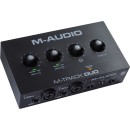
M-Audio M-Track Duo |
VS | ||
|---|---|---|---|
| Analog: 2 Inputs / 2 Outputs at 192 kHz |
Channels of I/O |
Analog: 2 Inputs / 2 Outputs at 192 kHz |
Analog: 2 Inputs / 2 Outputs |
| 48 kHz / 24-Bit | Maximum Sampling Rate | 192 kHz / 24-Bit | 48 kHz / 16-Bit |
| 2 Preamps | Number of Microphone Inputs | 2 | 1 Preamp |
| 2x Combo XLR-1/4" TRS Balanced/Unbalanced Mic/Line/Hi-Z Input (Front Panel) 2x 1/4" TRS Balanced Line Output 1x 1/4" TRS Unbalanced Headphone Output (Front Panel) |
Analog Audio I/O |
2x XLR 3-Pin Balanced Mic Input 2x 1/4" TRS Balanced/Unbalanced Line/Hi-Z Input (Front Panel) 2x 1/4" TRS Balanced Monitor Output 1x 1/4" TRS Headphone Output (Front Panel) |
1x Combo XLR-1/4" TRS Balanced Mic/Line Input (Front Panel) 1x 1/4" TRS Balanced/Unbalanced Line/Hi-Z Input (Front Panel) 1x Stereo RCA Coaxial Unbalanced Monitor Output 1x 1/8" / 3.5 mm TRS Unbalanced Headphone Output (Front Panel) |
| 1x USB-B (Class-Compliant) | Host Connection | 1x USB-C | 1x USB-B (Class-Compliant) |
| macOS 10.8 or Later Windows 7 or Later (32-/64-Bit) |
OS Compatibility |
macOS Windows |
macOS 10.8 or Later Windows 7 or Later (32-/64-Bit) |
| USB Bus Power | Power Requirements | USB Bus Power, USB Power Adapter (Not Included) | USB Bus Power |
